MARIANI’SVirtual Gourmet
May 27, 20012
NEWSLETTER

by John Mariani
NEW YORK CORNER
Hudson
Valley Dining:
Flames Steakhouse and MP Taverna
by John Mariani
NOTES FROM THE WINE CELLAR
With Madeira, Older May Well Be Better
by John Mariani
❖❖❖
OUR
FAVORITE MANSIONS:
Glenmere
on the Hudson
by John
Mariani

"Fanaticism,"
said George Santayana, "consists in
redoubling your effort when you have forgotten
your original aim." Had he met Dr. Daniel De Simone and
Alan Stenberg (below)
and seen Glenmere, I'm sure Santayana would have
meant that as a high compliment. For what is
one to make of a dedication,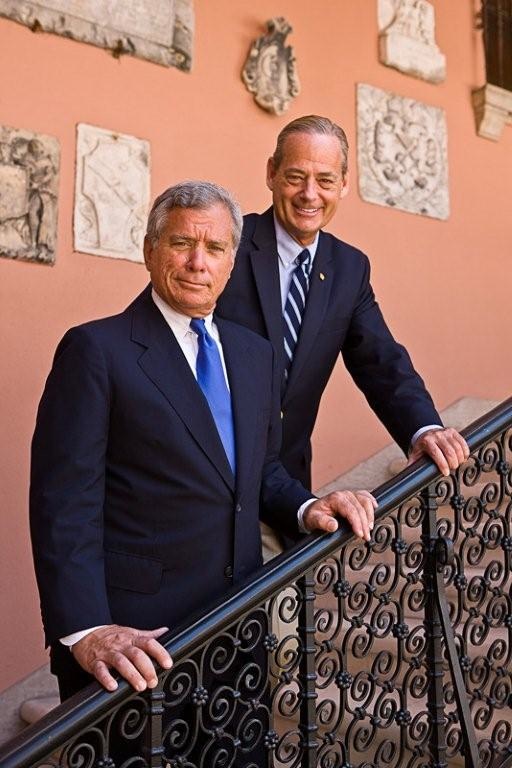 commitment, and the expenditure of great gobs of
money that results in a project that very probably
has no end in sight? And that is Glenmere, an
astonishment of beauty and high taste, an act of
architectural bravado evident in every tile,
panel, bookshelf, curtain, painting, and wall
sconce, polished, while seeming always to need a
tweaking here, an addition there.
commitment, and the expenditure of great gobs of
money that results in a project that very probably
has no end in sight? And that is Glenmere, an
astonishment of beauty and high taste, an act of
architectural bravado evident in every tile,
panel, bookshelf, curtain, painting, and wall
sconce, polished, while seeming always to need a
tweaking here, an addition there.
I have been to some glorious
converted mansions around the world, but certainly
none moreso than Glenmere, built in 1911 for
industrialist Robert Goelet, one of the richest and
famous men in the country back then, who lived here
with his family until selling the 3,000 acre estate in
the Hudson Valley in 1940. Goelet had already
been selling off parcels 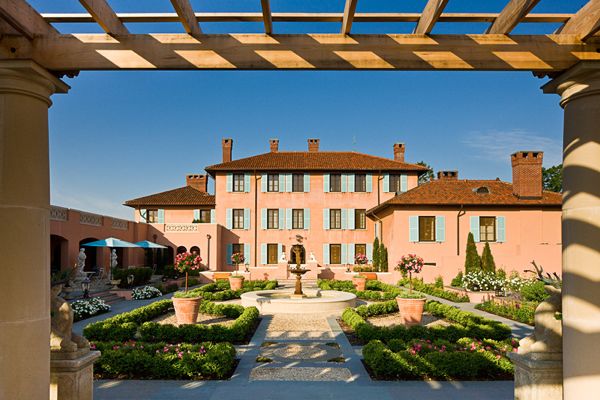 of land for
years, so that now the current acreage is down to a
mere 150 acres that roll through forests and prim
gardens down to glassy Glenmere Lake, all of it a
setting for taking in sunrise and sunset from its vast
windows.
of land for
years, so that now the current acreage is down to a
mere 150 acres that roll through forests and prim
gardens down to glassy Glenmere Lake, all of it a
setting for taking in sunrise and sunset from its vast
windows.
Curiously
enough, Glenmere is a surprise as you wind your way up
to its broad lawns. You expect it to fit more into
some vague idea of Hudson Valley architecture with
gables and steeples and timbered walls. Yet
Carrère and Hastings, leading architects of the
day who usually worked in the Beaux Arts style--they
did the NY Public Library--here produced an Italian
villa of a kind that would seem more likely to
overlook a lake in Tuscany. Beatrix Jones
Farrand, America’s first major female landscape
architect, did the gardens, now impeccably restored.
When the Goelets lived here they had 45 rooms; now, as
a resort, the mansion has just 18 for guests.
Since the 1940s the place had
become rundown, so when Dr. De Simone retired with
former public relations firm owner Stenberg to Tuxedo
Park, they found at Glenmere a promising place to open
a deluxe inn. Upon seeing the place and
imagining what it must have cost--thus far--I asked
the ebullient Mr. Stenberg if he'd ever seen the movie
"Mr. Blandings Builds His Dream House," a comedy of
errors about the restoration of a country house by
Cary Grant and Myrna Loy in which every scene reveals
new architectural and landscape deficiencies that cost
many times their original estimates. Stenberg
said it was one of his favorite movies.
 At one point, for months on
end, one hundred artisans were working seven days a
week to get Glenmere into livable shape, which
included such unexpected oddities as drawing thermal
heat from deep in the earth. One thing
inevitably led to another, and another, and another,
and when I joked to my wife, "Hey, let's buy the
place!" Stenberg leaned in and said, "Every house is
for sale."
At one point, for months on
end, one hundred artisans were working seven days a
week to get Glenmere into livable shape, which
included such unexpected oddities as drawing thermal
heat from deep in the earth. One thing
inevitably led to another, and another, and another,
and when I joked to my wife, "Hey, let's buy the
place!" Stenberg leaned in and said, "Every house is
for sale."
Yet
for all their work, with the investment of a congenial
German industrialist who told them turning a profit
and inn would take, uh, some time, I cannot imagine
the two innkeepers giving up what they have so
decorously reveled in, from every art book set on
every table, from the tiny deer antlers lining a hall
to the spa, and to the spa itself, which is not just
state of the art all its own, but set with individual
rooms for any salon and spa treatment you could
possibly think of, including a hammam wash and
massage, soaking tub, vanity, steam shower, sauna,
double shower, and gorgeously inventive fireplace.
The fine art at Glenmere is very
fine indeed, from the collection of Alison and Peter
Klein. Each guest room has been individually decorated
by interior designer Scott Snyder, all with an eye to
peaceful surroundings to match the outdoors, along
with every modern amenity and good old-fashioned ones
like working fireplaces. (I'm sure the thread count of
the bedsheets is in the zillions!) There is a
private elevator that takes you up to the Penthouse
suite of two bedrooms and two baths.
The Supper Room (right) is pure
enchantment, the kind of dining room you'd imagine
Jacqueline Bouvier Kennedy hosting a dinner, and
attached are two equally lovely private dining rooms.
Frogs End is a tavern available for lunch and evening
meals, but its real draw is the onyx bar, reproduced
from a favorite the owners had seen in Europe. 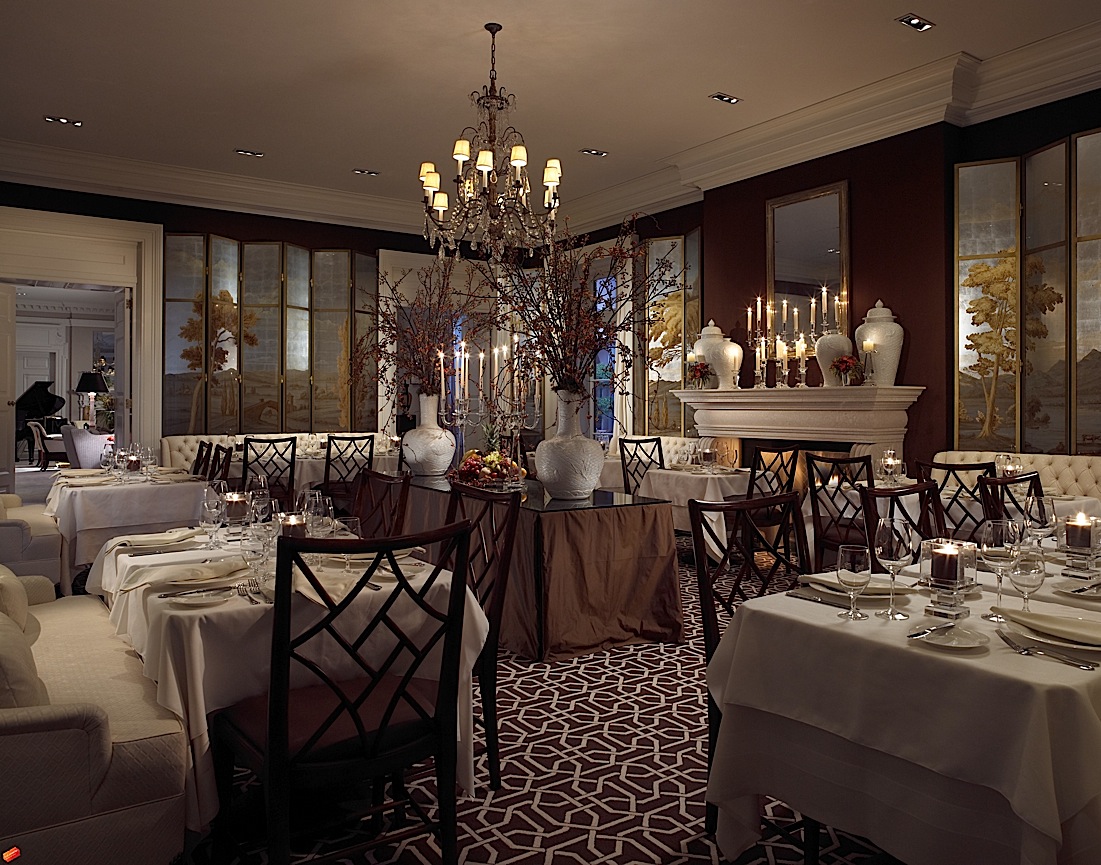
We had a fine
spring evening's meal at The Supper Room, which is
open to the public, that included Chef Seadon Souse's
Hudson Valley foie gras with caramel apple,
mâche, and lemon vinaigrette; agnolotti of
pumpkin with crispy pancetta,
Swiss chard, and sage brown butter; and an
espresso-rubbed short rib of beef with sunchoke puree,
wild mushrooms, and braising greens. At $75
fixed price, it's quite a bargain.
Even moreso, the winelist, by
sommelier Michael Cimino, has depth and breadth across
a global spectrum, and the prices are amazingly
reasonable--a decision he and the owners made to
encourage people to enjoy good wines without sticker
shock.
How does Glenmere compare with its
sister properties in the Relais & Château
membership--places like Château Les
Crayères in Reims, Le Manoir aux Quat'Saisons
in Milton, England, Il Pellicano in Porto Ercole,
Italy, Blackberry Farm in Walland, Tennessee, and
Auberge du Soleil in Napa Valley? Let's just say that
the owners of all these illustrious properties could
learn a thing or two from Glenmere.
As might be expected in a place so
uniquely situated, weekends are almost always booked,
with a two-night minimum. Otherwise, rates run from
$650-$3,500 for the penthouse, including breakfast. By
the way, depending on the season, you may rent the
whole shebang for $25,000 to $50,000, with use of all
facilities. Call a dozen of your closest friends
and have a bash.

Glenmere is
located at 634 Pine Hill Road in Chester, NY;
845-469-1900; www.glenmeremansion.com.
❖❖❖
NEW
YORK CORNER
Hudson Valley
Dining
by
John Mariani

"View of the Hudson Valley from Olana"
by Frederick Edwin Church
The
Hudson Valley just a bit north of Manhattan and
the Bronx and well below Albany is fertile
territory for good restaurants, which include
Hudson House in Nyack, Crabtree's Kittle House
in Chappaqua, Xaviar's at Piermont, and several
others, all with an ambiance that fits the
beauty of the territory. If you stay at
Glenmere, above, or are merely hungry for fine
food, here are two of my favorites a classic
American steakhouse, another a brand new Greek
restaurant from a star chef.
Flames Steakhouse
and Italian Cuisine
533 North State Road
Briarcliff Manor, NY
914-923-3100
flamessteakhouse.com
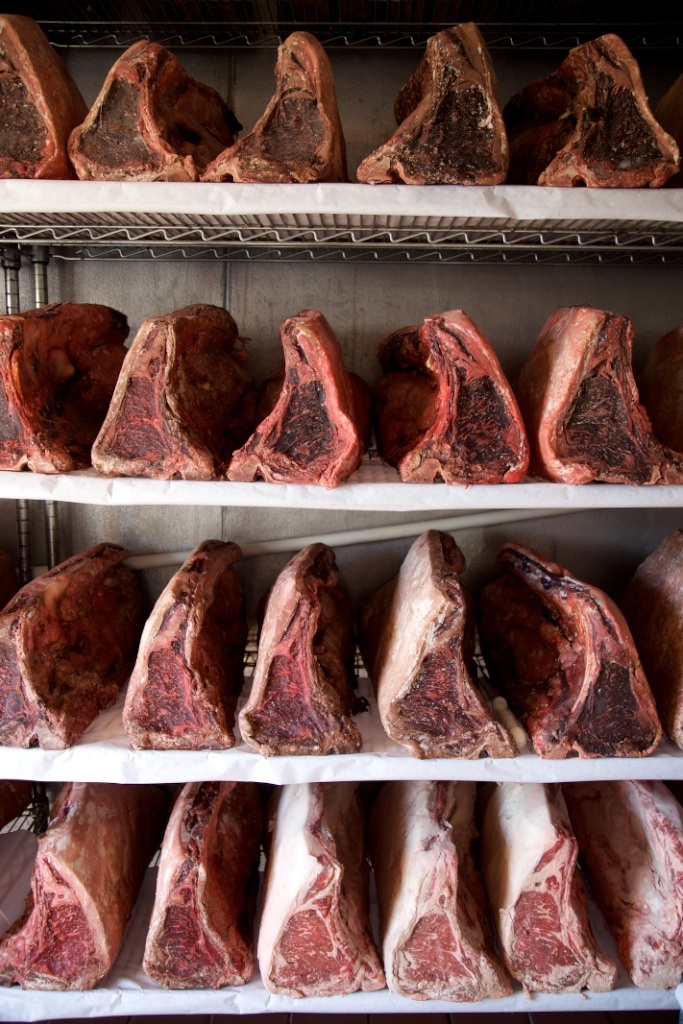 Over
the past few weeks, in five different cities, I've had
occasion to taste steaks heralded on the menus as
being top-of-the-herd USDA Prime beef. Yet the
kind of intense, beefy, fat-rich flavor I once
expected from such a grade of steak just wasn't there.
This has been a problem for some time now, as more and
more steakhouses open and compete for Prime beef,
which there just isn't enough of to go around, and the
Prime grade is not what it used to be anyway.
(By the way, I learned an interesting item from my
butcher, Sal Biancardi of Biancardi's in the Bronx:
Feed lots now re-use corn whose sugars have been
distilled into ethanol, so the spent corn hasn't the
carbo-loading power to bulk up a steer to have
consistent marbling in the muscle; less fat marbling,
less flavor.)
Over
the past few weeks, in five different cities, I've had
occasion to taste steaks heralded on the menus as
being top-of-the-herd USDA Prime beef. Yet the
kind of intense, beefy, fat-rich flavor I once
expected from such a grade of steak just wasn't there.
This has been a problem for some time now, as more and
more steakhouses open and compete for Prime beef,
which there just isn't enough of to go around, and the
Prime grade is not what it used to be anyway.
(By the way, I learned an interesting item from my
butcher, Sal Biancardi of Biancardi's in the Bronx:
Feed lots now re-use corn whose sugars have been
distilled into ethanol, so the spent corn hasn't the
carbo-loading power to bulk up a steer to have
consistent marbling in the muscle; less fat marbling,
less flavor.)
One place I can
always count on for the kind of beef you only find at
a handful of NYC steakhouses like Peter Luger and the
original Palm is Flames (est. 1992) in Briarcliff, about 45 minutes to an hour from midtown
Manhattan. At Flames 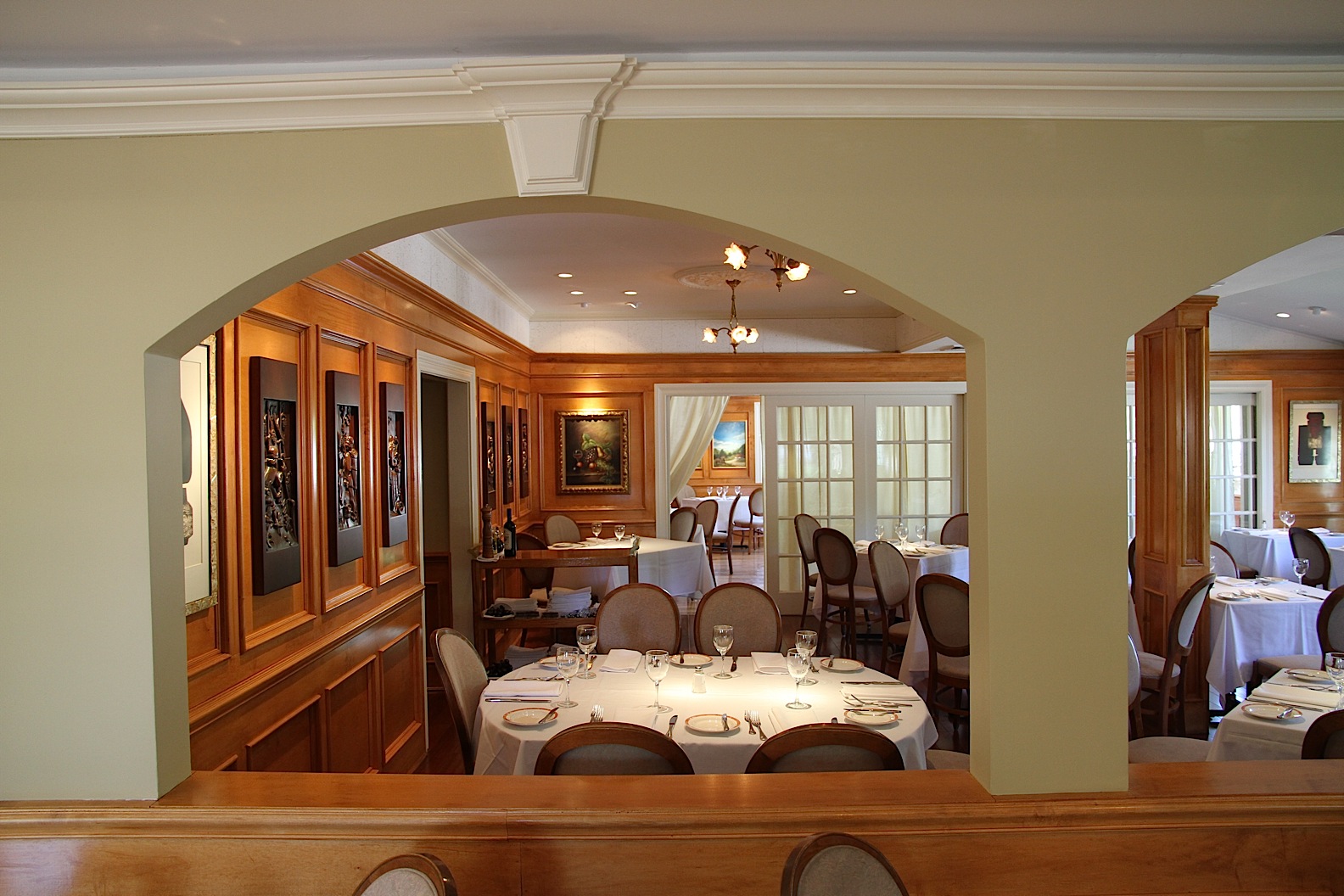 you get
dry-aged beef (left)
that is beautifully aged and wonderfully marbled,
attributes contributing to a steak among the very best
in NYC.
you get
dry-aged beef (left)
that is beautifully aged and wonderfully marbled,
attributes contributing to a steak among the very best
in NYC.
That fine beef is cooked at 800 degrees
to seal in the juiciness and char the
exterior--another process missing in so many
steakhouses these days.
The man behind this consistent excellence is Nick
Vulaj, a mustachioed detail freak who makes sure
everything that comes out of his kitchen, including
the waiters, is first rate. You will never wait more than a
milli-second for them to respond to any request you
might have.
Flames's winelist is one of the
largest and best in the Tri-State region, with
more than 400 labels and 60,000 bottles of every
description and price point, many stored in an
exquisite downstairs private dining room in the
temperature-controlled wine cellar (below).
The menu goes farther than most
basic, traditional steakhouses, offering several
pastas and non-steak items, along with the various
cuts of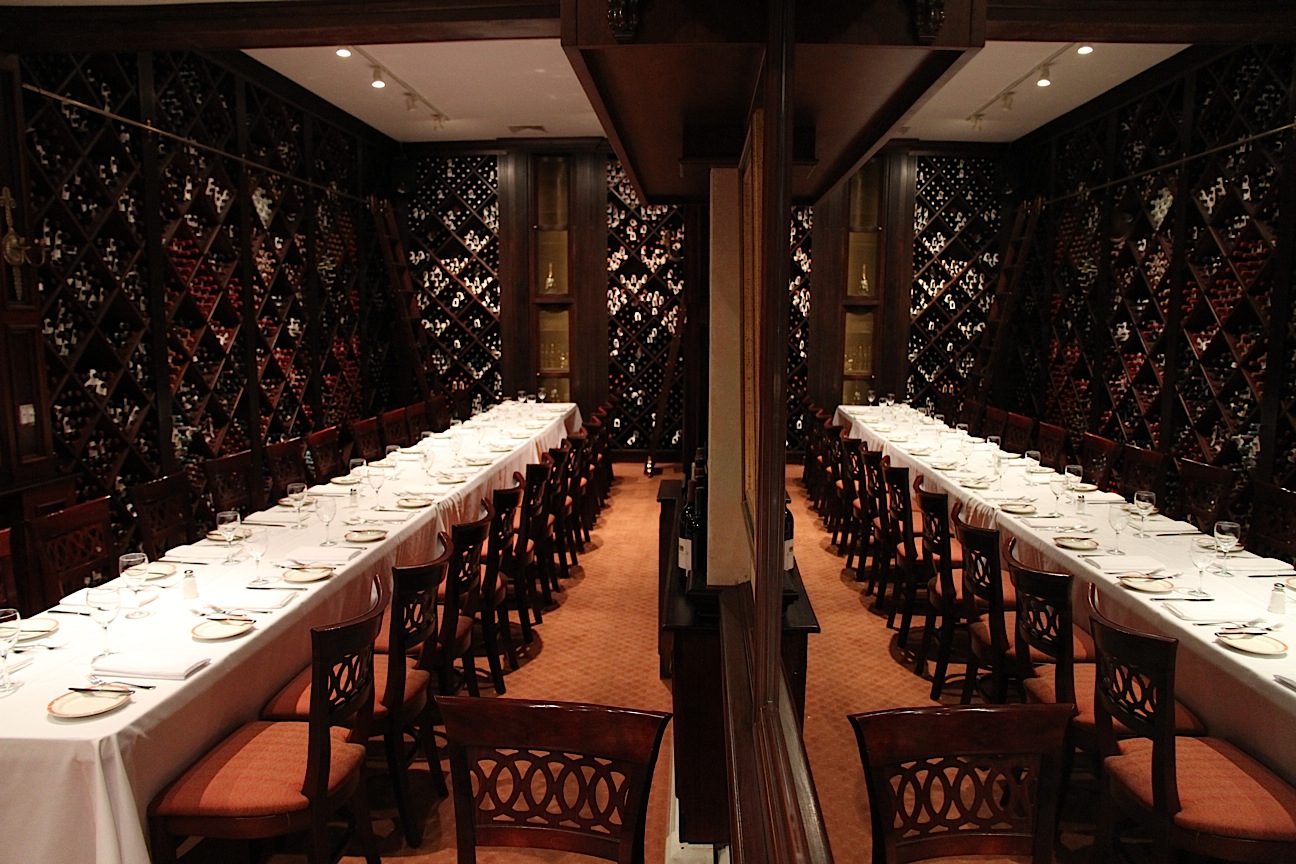 beef and the behemoth-like
lobsters, steamed and cracked and served with
clarified butter, alongside perfect, golden onion
rings, buttered mashed potatoes, home fries, luscious
creamed spinach and fat sweet asparagus.
beef and the behemoth-like
lobsters, steamed and cracked and served with
clarified butter, alongside perfect, golden onion
rings, buttered mashed potatoes, home fries, luscious
creamed spinach and fat sweet asparagus.
The sirloins--my favorite cut to
show the true mettle of a steakhouse--are nonpareil;
the porterhouse, sliced in the sizzling style begun a
century ago at Peter Luger's, is for two or more
people. The succulent veal chop is massive, and worth
every penny at $34.95.
Among recommended appetizers are
generous slices of carpaccio, big meaty shrimp (below), and
mozzarella in
carozza (a steal at eight bucks). Fried
calamari are greaseless and sushi-grade tuna gets a
swipe of wasabi.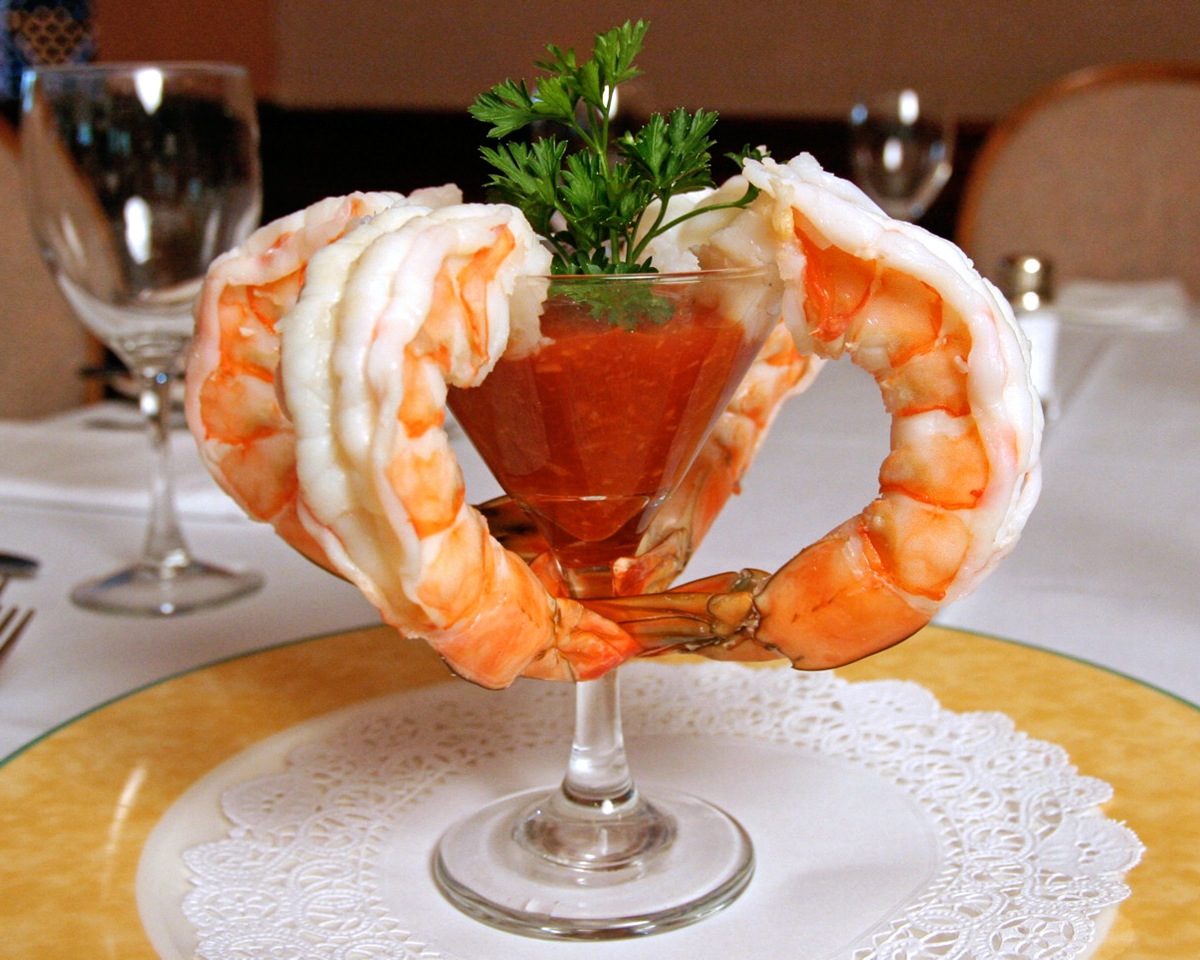
I
would wait a little while longer into mid- to late
summer before ordering the sliced tomatoes and
onion, but once the tomatoes bloom, Nick will have the
sweetest.
There are some good veal scaloppine
dishes--the "Mt. Etna," with balsamico, roasted peppers and
cherry peppers is excellent--along with a fine saltimboca.
You still want dessert, maybe to
share? Go for the terrific crème
brûlée, the thick slab of pecan pie with
vanilla ice cream, or the creamy New York cheesecake,
all made on premises.
Since Nick does not pay NYC real
estate prices here--though he has another restaurant
in the Financial District named Giardino d'Oro--prices
for everything at Flames are lower, and the service,
so often a brusque routine in Manhattan and Brooklyn,
is as attentive as you want it to be.
So, if you remember how steaks used to taste in
NYC and don't want to drive to Brooklyn or suffer
indignities at the bar at Spark's, head up the Hudson
Valley and eat the way you did twenty years ago,
with exemplary service and great wines in the bargain.
MP TAVERNA
One Bridge Street
Irvington, NY
914-231-7854
www.michaelpsilakis.com.
Photos by Michael Harlan, Oleg March and Daniel
Krieger
 The
Village of Irvington, named after the area's most
beloved writer, Washington Irving, who lived nearby at
Sunnyside, has a quaint river town charm, history--it
once had its own opera house and was home of America's
first female millionaire, Vera Lewaro--and fine,
varied architecture. Sleepy is the word often
applied to these Hudson Valley villages, and Irvington
is a quiet spot, now enlivened by MP Taverna, which
occupies a site that has seen a few restaurants come
and go in recent years.
The
Village of Irvington, named after the area's most
beloved writer, Washington Irving, who lived nearby at
Sunnyside, has a quaint river town charm, history--it
once had its own opera house and was home of America's
first female millionaire, Vera Lewaro--and fine,
varied architecture. Sleepy is the word often
applied to these Hudson Valley villages, and Irvington
is a quiet spot, now enlivened by MP Taverna, which
occupies a site that has seen a few restaurants come
and go in recent years.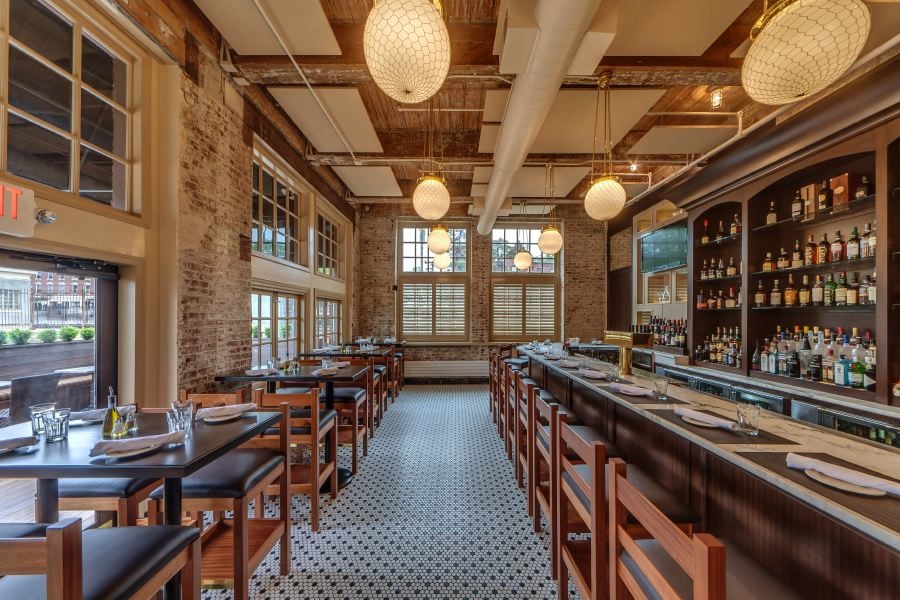
MP stands for Michael Psilakis (left), the
brilliant Greek-American chef who burst upon the scene
in 2007 with Anthos, a thoroughly modern take on Greek
cuisine, done with dash and high creativity--my pick
in Esquire
as best new restaurant of the year. His well-regarded
cookbook, How to Roast a Lamb, was published
in 2009. Some missteps, celebrity hype
and partnership break-ups drove Psilakis out of Anthos
back into more traditional forms of Greek food with
Kefi and FISHTAG on the Upper West Side, and another
unit of MP Taverna, in Roslyn, Long Island, and
another on the way in Astoria, Queens.
The Irvington restaurant, with 120
seats and patio, is set in an 18th century
building that has seen a few restaurants come and go
over the years. There's a lot of mahogany wood, pine
floors, brass chandeliers, shelves of glass
vases, distressed brick, roomy brown leather
booths, black and
white floor tiles in the lounge (right), with a
marble-topped bar, and four larger tables that
seat 16. Would that this charming decor had
tablecloths rather than dark brown tabletops. The
20-seat outdoor deck is outfitted with white marble
table tops and dark brown wicker seating.
 Westchester
County is far from rich in Greek restaurants, so MP
would be welcome anywhere,
Westchester
County is far from rich in Greek restaurants, so MP
would be welcome anywhere,
The heart of Middle Eastern food
is in the mezes,
and Psilakis offers a baker's dozen, plus a
selection of dips with pita bread. The barrel-aged
feta with olive oil and a sprinkling of oregano had
the right tang and texture, while the octopus (below) was not
just among the most tender I've had anywhere but
also the most flavorful. The biggest hit of the
evening were a plate of hefty gyro sliders, whose
juicy shreds of meat were well seasoned with
pepperoncini and onion and set on a little bun that
itself was delicious. Also impressive was a
generous platter of spiced pork ribs with smashed
potatoes; not particularly smoky, the meat was an
ideal balance of fat and lean and came off the bone
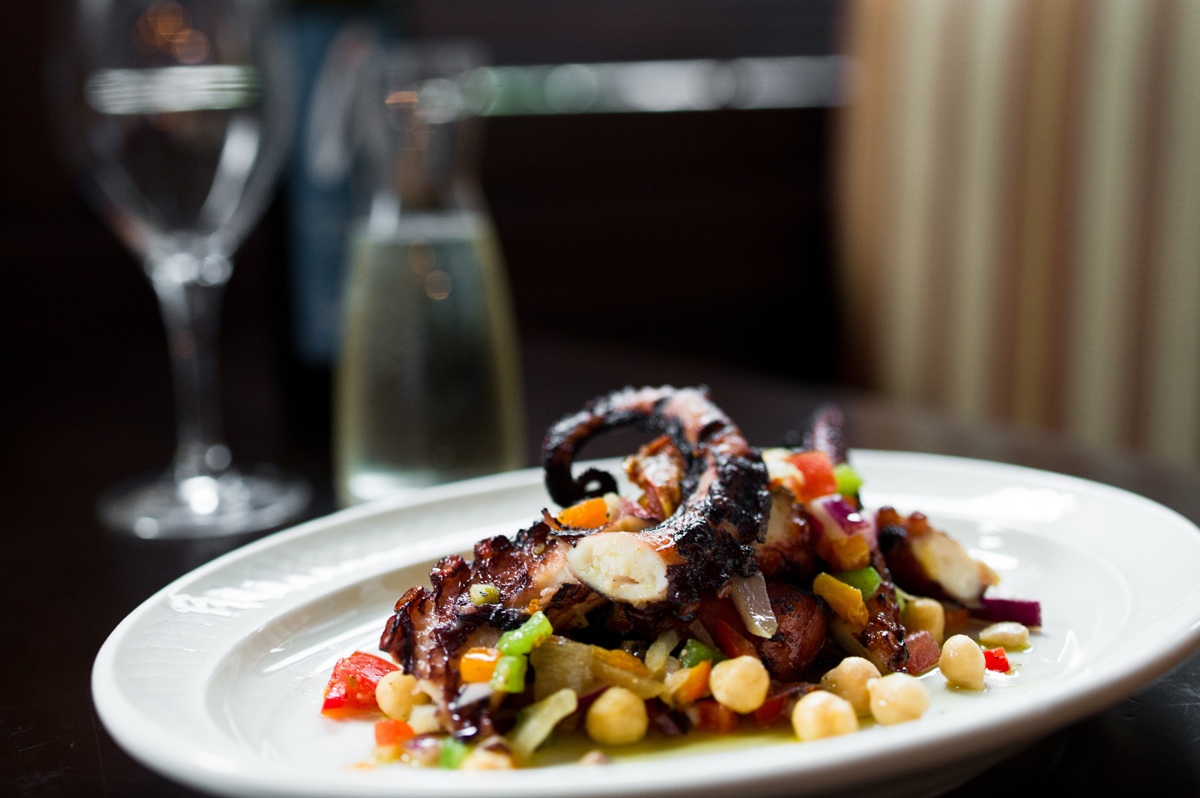 full of
succulence. The dips--savory eggplant with roasted
peppers and garlic, chickpeas with sun-dried tomato
and herbs, and housemade yogurt with cucumber and
dill--available separately or all three for $12. The
night's only disappointments were the mushy texture
of some otherwise good meatballs and the barely
warm, somewhat chewy pita bread.
full of
succulence. The dips--savory eggplant with roasted
peppers and garlic, chickpeas with sun-dried tomato
and herbs, and housemade yogurt with cucumber and
dill--available separately or all three for $12. The
night's only disappointments were the mushy texture
of some otherwise good meatballs and the barely
warm, somewhat chewy pita bread.
Every entree was a standout.
Where to begin? Greek paella had an abundance of
shellfish, each impeccably cooked, and lamb sausage
in a heady broth. A grilled branzino (below) could
not possibly have been better cooked, a large piece
of beautiful fish whose crispy skin was entirely
edible, atop firm flesh oozing juiciness. If you
like Italian gnocchi, you'll love the fat dumplings
here with lamb sausage, sun-dried tomato, pine nuts,
spinach, tomato and feta. Lamb shank was textbook
perfect, with orzo pasta around it in the juices of
the meat. Finally, I'm ready to pronounce Psilakis'
roasted lemon chicken in a rich, velvety garlic and
dill the most delicious chicken dish I can remember
in years--a masterpiece of good ingredients cooked
with imagination and finesse. Did 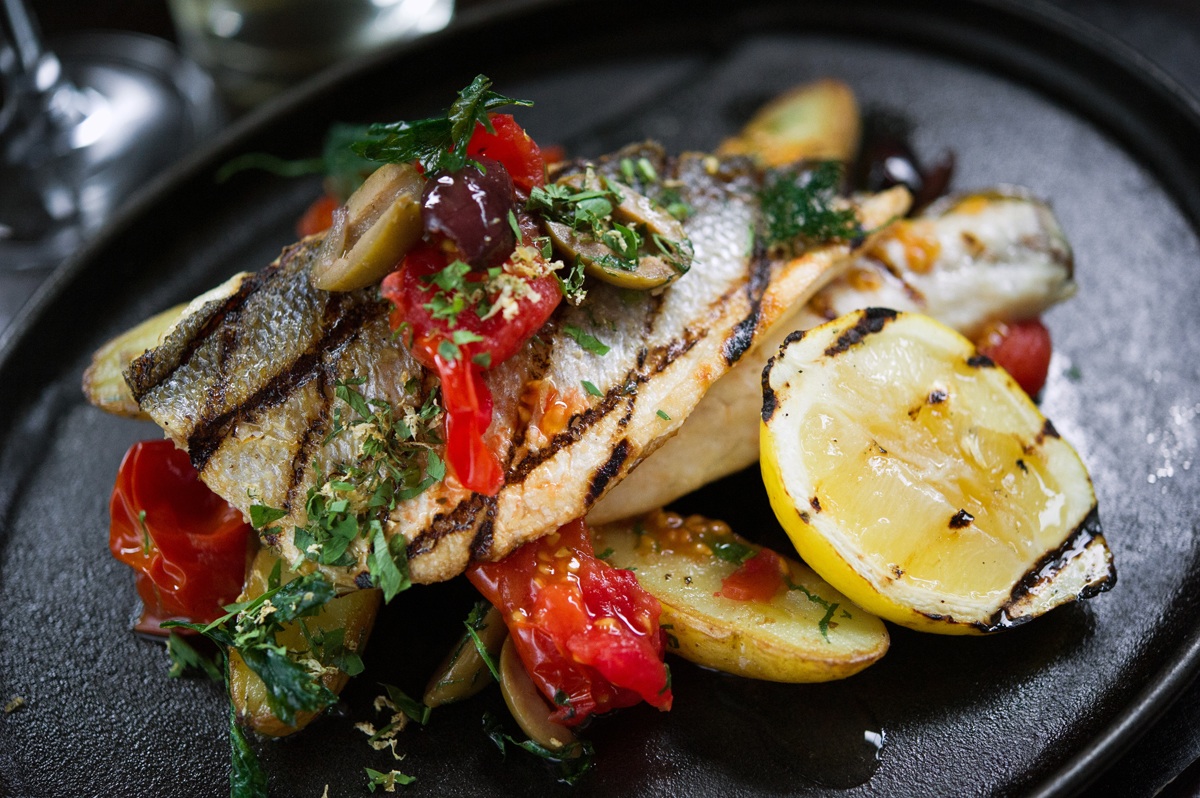 I mention
it's just $15 on the menu?
I mention
it's just $15 on the menu?
All desserts toed the same
careful line as what preceded them, from a lovely
spiced walnut and parsnip cake with cream cheese
frosting and maple walnut ice cream to a chocolate
halvah brownie with tahini creme anglaise and sesame
ice cream. The apple baklava-like napoleon had a
fine texture of shredded phyllo pastry over metxa
ice cream and amaretto crunch ice cream.
There are more than 50 bottles
of wine available in three- and six-ounce pours, as
well as a good selection of international beers. Oddly
enough, though, there is only one white and one red
Greek wine on the list, a startling omission
(especially since they were out of the listed red that
night, and the vintages were already out of date). A
place like this should be championing the great
strides made in Greek wine in the past decade.
I worry that Psilakis may soon
overextend himself with too many restaurants, but I
sense that most of the food at MP Taverna can be made
by a well-trained kitchen staff to come out with
consistency. Right now, this is some of the most
exciting Greek food in the region, and I think
Psilakis is well on his way to have such food enter
the mainstream.
MP Taverna is open for
lunch Mon.-Fri., Brunch Sat. & Sun., and dinner
nightly.
WITH MADEIRA,
OLDER
MIGHT REALLY BE BETTER
by
John Mariani
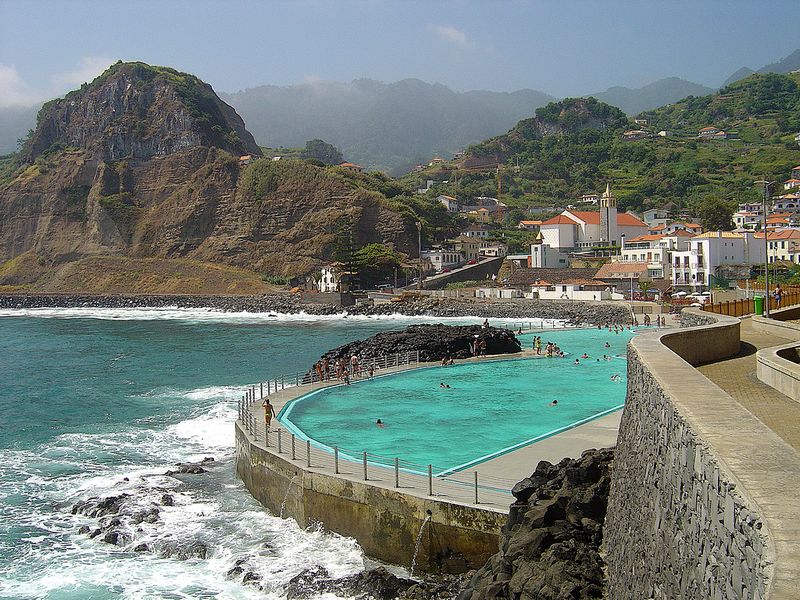
Porto da Cruz, Madeira
 Even more
surprising was my finding that the 1910 Barbeita Sercial
($350) was the best of a dozen Madeiras sampled at a
Wine Media Guild tasting last month [MAY]. For a wine
more than a century old, this was voluptuous but not
fatty, fully balanced between fruit and acid, with a
deep richness that gave way to a light finish. Indeed,
it is the acids in Madeira, which increase with age,
that keep centenarians like this tasting so fresh,
along with the added fortifying alcohol that, like
Port, allows for such longevity.
Even more
surprising was my finding that the 1910 Barbeita Sercial
($350) was the best of a dozen Madeiras sampled at a
Wine Media Guild tasting last month [MAY]. For a wine
more than a century old, this was voluptuous but not
fatty, fully balanced between fruit and acid, with a
deep richness that gave way to a light finish. Indeed,
it is the acids in Madeira, which increase with age,
that keep centenarians like this tasting so fresh,
along with the added fortifying alcohol that, like
Port, allows for such longevity.
Madeira is made on the volcanic Portuguese
island of the same name, where it began as an
unfortified white wine.
But shippers found that the addition of alcohol
helped stabilize the wine on long trade voyages,
particularly to America where it was by far the most
popular wine of the 18th century
when the colonies imported a quarter of all the
Madeira produced.
Over the next two centuries Madeira had its ups
and downs, from crises caused by powdery mildew and
phylloxera infestation to supply. Once there were
about 200 producers on the island, but today only
about seven are left. The biggest markets—for cooking
Madeiras and lesser varieties—are France, Germany, and
the Benelux countries.
For better Madeiras, the U.S. Japan and the
U.K. import most.
Madeira can be made from a variety of grapes,
including Tinta Negra Mole, Sercial, Verdelho, Bual,
and Malvasia, usually listed on the labels of better
bottlings. Three-year and five-year Madeiras are
blends whose youngest wine is the number indicated.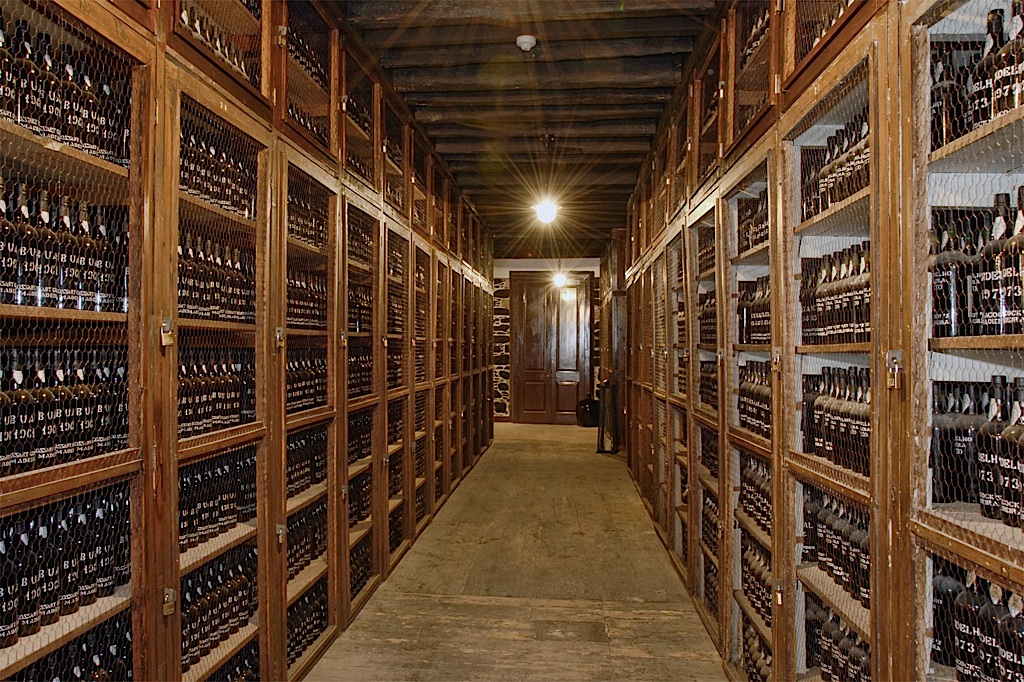 Those are
mostly supermarket wines, but ten-year and 15 Madeiras
offer considerably more quality at very decent prices.
Those are
mostly supermarket wines, but ten-year and 15 Madeiras
offer considerably more quality at very decent prices.
A vintage Madeira, called a frasqueria, is
basically drawn from a cask from a single year and
must spend a minimum of 20 years in oak barrels for
aging.
The wine
library at Bual
The
Madeiras
at the tasting, most imported by the Rare Wine
Company, showed a remarkable range. One very light,
pretty example was the 1988 Barbeito Sercial ($47), while the
1978 vintage of the same wine was pale in color but
spicy, with a perfect balance of acid to make it
delicious before dinner as well as afterward.
The 1985
D’Oliveira Verdelho ($95) was slightly
vegetal, somewhat grassy, while a younger vintage,
1994 ($80), had a tremendous bouquet, bright acids,
and levels of flowery, spicy flavors that finished
long on the palate. The older 1973 was
magnificent—with a burnt sugar nose that changed to a
restrained elegance and mild sweetness that would make
it such a fine wine with a creamy Portuguese blue
cheese like Serpa or Serra da Estrella. The 1912,
still sound as a bell, was bracing, coppery, as if it
were just minted yesterday.
Turning to a series of Bual-based
Madeiras, produced in warmer terroirs on the island, I
found all of them showing some oxidation, tasting not
unlike Spanish sherries, which was pleasant enough in
the 1966 Blandy
(price n/a). The 1977 ($135-$170) was one-dimensional,
not particularly sweet  (though Boals generally achieve higher
sugar levels than Sercials and Verdelhos). But two
other examples, 1968 ($150-$200) and 1920 ($700-$800),
were distastefully oxidized, musky tasting, and murky. Indeed, the
1920 (left)
was brown and smelled so badly I couldn’t bring myself
to taste it.
(though Boals generally achieve higher
sugar levels than Sercials and Verdelhos). But two
other examples, 1968 ($150-$200) and 1920 ($700-$800),
were distastefully oxidized, musky tasting, and murky. Indeed, the
1920 (left)
was brown and smelled so badly I couldn’t bring myself
to taste it.
Aside from its formidable aging potential and
its variety, the truly remarkable thing is how
relatively inexpensive it is. When you think you can
easily spend $300-$1000 on a bottle of Champagne or
Burgundy for a single night’s pleasure, Madeiras are
meant to be sipped over many evenings in small doses. They don’t
keep forever once opened, but they will be just as
rewarding for weeks, long after the Champagne and
Burgundy bottles have been recycled into mere glass.
John Mariani's wine column appears in Bloomberg Muse News, from which this story was adapted. Bloomberg News covers Culture from art, books, and theater to wine, travel, and food on a daily basis.
❖❖❖
DEPARTMENT OF AMPLIFICATION
In response to my article last week, "When Did Tipping Become a Stick-up?" an astute and worldly reader, Michael Taylor, wrote to amplify what I said about not needing to tip on hotel and restaurant bills in France beyond a few euros for the bellhop or exceptional service.

In France and French territories, the legal
requirement on menus and
bills, though formerly "service compris," has for some years been the mention, "Prix net."
This indicates that
all charges are included in the price and no
further tip is required. The notion of a "service charge" became
obsolete because of the requirement to pay at least
the legal minimum wage to all employees.
For many years "service," consequently
considered by most employers as simply a part of
revenue because all employees were salaried staff
(leading to payroll costs often as high as 40% to 65%
of F&B revenues), was simply never paid out to
service employees. Some very rare
establishments still pay "intéressement" or a
percentage of revenue, gross or net, though less often
to non-executive employees, but it generally has
little to do only with menu prices and percentage of
restaurant or bar checks and is often based on the
company's or group's net results.
So, if guests or banquet & event organizers
want to "tip" for exceptional service, they may.
However, no official
receipt can be provided
by the establishment for that. Tips on credit cards
can usually, though not always, be made, and are
generally returned to staff (who vigilantly track
them) often with hefty social security and other
payroll taxes deducted. Gratuities are appreciated,
though not a
requirement, and at guests' discretion.
ALSO: A Bob
Dylan fan points out I misquoted him. He did not say
"Money doesn't talk, it screams."; he said "Money
doesn't talk, it swears."
❖❖❖
NOT
TO MENTION THEIR EATING PORK 
RINDS OUT OF THE BAG WHILE DRIVING
Researchers
at University of Buffalo released a study that showed
morbidly obese people are 56 percent more likely to
die in car accidents than people of normal weight
because those who are overweight are less likely to
buckle up because the seat belts aren’t big enough to
span some their girth.
AND DON'T FORGET ABOUT THE PRIAPIC POP OF
THE PEA PODS!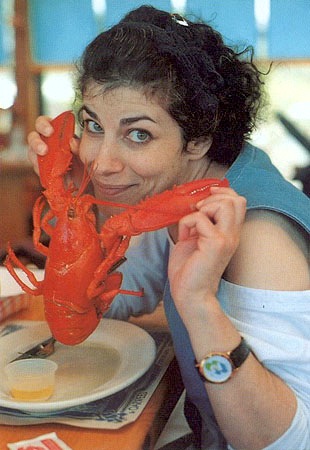
“I suppose we
could judge chefs by the notches on their belts, but I
prefer the fragrance of the leather. I like the
buttery clutch Michael Symon has with meats, the
swashbuckling Johnny Depp daring of Jonathon Sawyer,
the expert massage of Americana from Karen Small and
Doug Katz. The list goes on. Bruell is the most
painterly among them, always adding a splash of
intrigue. Who has tasted his signature cassoulet at
L'Albatros and doesn't remember the bling of fennel
gastrique that makes all the rustic flavors shimmer?
So it was strange to poke the outside of my Crispy
Giant Pork Shank and get flab, not crackle. Sigh, chicharrone
dreams deferred.”—Debbie Snook, "Cowell &
Hubbard," Cleveland Plain Dealer.
❖❖❖
Any of John Mariani's
books below may be ordered from amazon.com.
 |
My latest book, which just won the prize for best book from International Gourmand, written with Jim Heimann and Steven Heller, Menu Design in America, 1850-1985 (Taschen Books), has just appeared, with nearly 1,000 beautiful, historic, hilarious, sometimes shocking menus dating back to before the Civil War and going through the Gilded Age, the Jazz Age, the Depression, the nightclub era of the 1930s and 1940s, the Space Age era, and the age when menus were a form of advertising in innovative explosions of color and modern design. The book is a chronicle of changing tastes and mores and says as much about America as about its food and drink.
“Luxuriating vicariously in the pleasures of this book. . . you can’t help but become hungry. . .for the food of course, but also for something more: the bygone days of our country’s splendidly rich and complex past. Epicureans of both good food and artful design will do well to make it their coffee table’s main course.”—Chip Kidd, Wall Street Journal.
“[The menus] reflect the amazing craftsmanship that many restaurants applied to their bills of fare, and suggest that today’s restaurateurs could learn a lot from their predecessors.”—Rebecca Marx, The Village Voice. |
"Eating Italian will never be the same after reading John Mariani's entertaining and savory gastronomical history of the cuisine of Italy and how it won over appetites worldwide. . . . This book is such a tasteful narrative that it will literally make you hungry for Italian food and arouse your appetite for gastronomical history."--Don Oldenburg, USA Today. "Italian
restaurants--some good, some glitzy--far
outnumber their French rivals. Many of
these establishments are zestfully described
in How Italian Food Conquered the World, an
entertaining and fact-filled chronicle by
food-and-wine correspondent John F.
Mariani."--Aram Bakshian Jr., Wall Street
Journal.
"Equal parts
history, sociology, gastronomy, and just
plain fun, How Italian Food Conquered the
World tells the captivating and delicious
story of the (let's face it) everybody's
favorite cuisine with clarity, verve and
more than one surprise."--Colman Andrews,
editorial director of The Daily
Meal.com. "A fantastic and fascinating
read, covering everything from the influence
of Venice's spice trade to the impact of
Italian immigrants in America and the
evolution of alta cucina. This book will
serve as a terrific resource to anyone
interested in the real story of Italian
food."--Mary Ann Esposito, host of PBS-TV's
Ciao
Italia. "John Mariani has written the
definitive history of how Italians won their
way into our hearts, minds, and
stomachs. It's a story of pleasure over
pomp and taste over technique."--Danny Meyer,
owner of NYC restaurants Union Square Cafe,
Gotham Bar & Grill, The Modern, and
Maialino.
|
 |
 |
 |
 |
 |
 |
 |
 |
❖❖❖
 Everett Potter's Travel Report:
Everett Potter's Travel Report: 
 Eating Las Vegas
is the new on-line site for Virtual Gourmet
contributor John A. Curtas., who since 1995
has been commenting on the Las Vegas food
scene and reviewing restaurants for Nevada
Public Radio. He is also the
restaurant critic for KLAS TV, Channel 8 in
Las Vegas, and his past reviews can be
accessed at KNPR.org.
Click on the logo below to go directly to
his site.
Eating Las Vegas
is the new on-line site for Virtual Gourmet
contributor John A. Curtas., who since 1995
has been commenting on the Las Vegas food
scene and reviewing restaurants for Nevada
Public Radio. He is also the
restaurant critic for KLAS TV, Channel 8 in
Las Vegas, and his past reviews can be
accessed at KNPR.org.
Click on the logo below to go directly to
his site.

Tennis Resorts Online: A Critical Guide to the World's Best Tennis Resorts and Tennis Camps, published by ROGER COX, who has spent more than two decades writing about tennis travel, including a 17-year stretch for Tennis magazine. He has also written for Arthur Frommer's Budget Travel, New York Magazine, Travel & Leisure, Esquire, Money, USTA Magazine, Men's Journal, and The Robb Report. He has authored two books-The World's Best Tennis Vacations (Stephen Greene Press/Viking Penguin, 1990) and The Best Places to Stay in the Rockies (Houghton Mifflin, 1992 & 1994), and the Melbourne (Australia) chapter to the Wall Street Journal Business Guide to Cities of the Pacific Rim (Fodor's Travel Guides, 1991).


MARIANI'S VIRTUAL GOURMET
NEWSLETTER is published weekly. Editor/Publisher: John
Mariani.
Contributing Writers: Christopher Mariani, Robert Mariani,
John A. Curtas, Edward Brivio, Mort Hochstein,
Suzanne Wright, and Brian Freedman. Contributing
Photographers: Galina Stepanoff-Dargery,
Bobby Pirillo. Technical Advisor: Gerry McLoughlin.
© copyright John Mariani 2012
